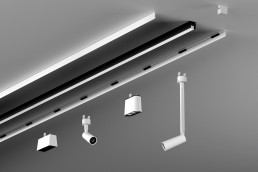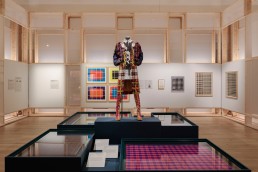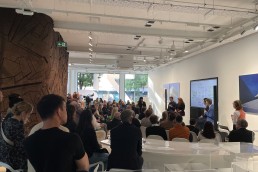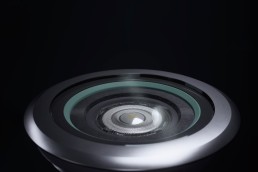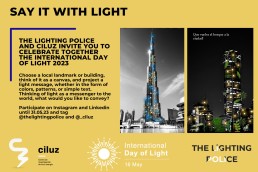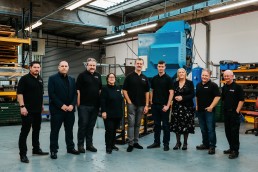David Morgan review: Simes IP System
Since its launch at Light + Building last year, the IP System from Simes has been causing a buzz among the lighting design community. Here, David Morgan takes a closer look at the range to see what all the fuss is about.
It is exciting and unusual to review a lighting system that combines a unique combination of features. The IP system from Simes is such a system. It combines an exterior rated silicone encapsulated diffuse linear lighting system with an exterior rated track system for projectors and accent lighting luminaires that can be added or removed along the length of the system.
Simes is based in Franciacorta, in the Brescia region of Italy north of Milan. The current firm was founded in 1973, although the origins of the company date back to 1957, when Edigio Botti started a metals machining company at his home. The company expanded and, in 1972, purchasing the Bruno Magnani company that specialised in exterior lighting. The company name was changed to Simes a year later and the first new product launched was a redesigned die cast bulkhead luminaire that was offered in a range of bright colours.
Under the management of Edigio Botti’s son, Roberto Botti, who has run the firm since 1990, the company has continued to grow and now employs 120 people. With sales distribution in more than 60 countries, around 70% of sales are outside Italy. All of the company’s components are designed in-house, and most are sourced from trusted local suppliers in the region.
The company has worked with a variety of high-profile designers to create new products since 1986. In 2016, I reviewed for arc magazine the innovative Simes Ghost concrete integrated range, designed by Marc Sadler.
The latest development from Simes is the IP System, which was unveiled at Light + Building in 2022 and has received an enthusiastic response from the lighting design community.
The original concept for an exterior IP rated track system was developed by Roberto Botti over many years. The eureka moment was apparently revealed in a dream when he realised the opal silicone used to encapsulate exterior linear lighting systems could also be used as a gasket in a waterproof track system. The Simes in-house design team got to work and quickly developed a working prototype to prove the design approach.
At the heart of the IP System is a custom flexible LED tape fitted with tight pitch LEDs. This produces the light output for the linear diffuse lighting system branded as the Highlighter by Simes. Running either side of the LED circuit are two additional copper conductor strips, which are used to power the plug-in projectors and other luminaires. The side conductors have a separate power supply from the central LED strip enabling each circuit to be independently controlled. A complex dual material silicone extrusion provides the diffusion for the LEDs and aims to seal the tape from water ingress.
The electrical connections between the plug-in luminaires and the conductive copper strips are made with sharp pins that pierce through the silicone diffuser without leaving space for water ingress. The silicone extrusion is housed in an aluminium extrusion, which gives the system it’s strength and rigidity. The plug-in luminaires snap onto the aluminium extrusion with stainless steel clips. Extruded aluminium side panels are then clipped onto the body extrusion to give a clean, finished appearance.
The Highlighter is available in both surface mount and ceiling recessed versions with lengths up to four metres. The system can be cut to a 50mm module, but this has to be done by Simes during production and cannot be undertaken on site. The Highlighter without any additional snap-in luminaires is rated at IP65. When the snap-in luminaires are first added, the IP rating remains at IP65 but once these luminaires are removed and then moved to a new position the rating for the whole system drops to IP54. I assume that the puncture holes in the silicone extrusion do not completely heal and may provide a water ingress path to the LED tape.
The snap-in luminaire installation is a little more complicated than I expected and requires the use of a patented, moulded jig to ensure that the contact pins pierce the silicone extrusion perfectly perpendicular to the surface. To protect the contact pins and ensure they are not distorted, a specially designed moulded cover is provided for each snap-in luminaire. Removing the luminaires from the track is also slightly difficult as the stainless-steel clips are an aggressive fit yet seem to allow the projectors in particular, to wobble slightly. It helps to remove the side panels before removing and repositioning the snap-in luminaires. For the ceiling recessed version this would mean removing the system from the ceiling before moving any of the snap in luminaires.
The sample I was given to test worked well with the caveat that there is a knack to getting the snap-in luminaires to make contact through the silicone extrusion. The lit effect from both the linear Highlighter and the snap-in luminaires was good with attractive, clean distributions.
The maximum wattage for all the snap-in luminaires per circuit is 60W, which may be limiting in some situations.
The range of plug-in luminaires includes two sizes of adjustable projectors: 5.4W and 8.6W. The larger size incorporates a zoom lens. Both sizes can be aimed and locked with grub screws. Snoot versions are also available.
In addition to the adjustable projectors, the IP System includes two styles of fixed downlight. A rectilinear wide flood type design in two sizes rated at 4.2W and 8.4W, and a radius end type with narrower optics rated at 4.2W.
A cylindrical 4.2W pendant available in flood and wide-flood distributions completes the current range of add-on luminaires.
The design of the system is well-detailed from an appearance point of view. However, construction of the luminaires involves the use of hard setting resins, which will make servicing, reuse, or recycling of the die cast and machined aluminium components problematic at the end of life, so the system does not fit into a circular economy model particularly well. It will be interesting to see how the system copes with high levels of heat and moisture in challenging environments over the long term.
The IP System is another example of the innovative and quite daring Simes design approach to luminaire development and the initial positive reaction from specifiers indicates that it will prove to be a commercial success.
GLA: Regulation and legislation of the Circular Economy
The GreenLight Alliance speaks to several members about the obstacles and opportunities to push towards a circular economy within lighting.
The lighting industry has begun to lean into its environmental responsibilities. It has far to go, but it’s happening. What more can be done? When the topic comes up, very often it is followed by a discussion on the associated legislation. This month we enquired of a few GreenLight Alliance members how they feel on the subject of legislation, asking “where are the obstacles and opportunities in terms of accelerating transition to a circular economy within our industry?”
Nigel Harvey, CEO, Recolight
Many companies within the lighting industry are undoubtedly starting to adopt circular economy principles. That is being driven by a growing awareness of the need for real sustainability which goes beyond energy efficiency, and embraces material efficiency as well. Many manufacturers, specifiers, and end users are now building circularity within their products. But to enable us to go further and faster, we undoubtedly need legislation and enforcement to drive the change.
That legislation should incentivise manufacturers and end users to do the right thing, and should also include mandatory requirements for products that are more “circular”.
Incentivise reuse and remanufacture
The easiest way to apply circularity in almost any situation is to keep existing product in use for longer, but with component upgrades to maximise energy efficiency. And although there is now significant interest in remanufacture within the lighting industry, it still only comprises a few percent, at best, of the total market. Government is already giving consideration to amending the WEEE regulations to recognise and reward remanufacture – possibly via a reduction in the WEEE financing obligations. But that should be extended to include fiscal measures that make reuse and remanufacture even more attractive to end users.
Incentivise ecodesign
Designing new products to embed greater longevity, durability, and upgradeability is also important. The government is currently considering incentives that could “ecomodulate” WEEE costs – with lower WEEE fees for “good” products and higher fees for “bad” products. The system is not without its challenges, but may well have merit.
Changes could also include product standards with a mandatory percentage of reused materials – particularly plastics. The painful reality is that unless recycled plastic is used in the manufacture of new products, the need for recycling at all comes into question.
Standardise the metrics
The industry is awash with a multiplicity of environmental product declarations, life cycle assessments, and similar. Knowing which to adopt is undoubtedly a challenge for all in the sector. Government could provide much needed direction and focus by encouraging or mandating a few methodologies.
Packaging
Defra has already legislated to make producers responsible for the full costs of collection and recycling of consumer packaging waste. For companies selling packaged consumer products, this will mean a significant increase in compliance costs next year. This will act as a strong incentive to reduce the amount of packaging used. Options should also be explored to extend this to commercial packaging.
Enforcement
New legislation is only effective when it is enforced. For far too long, there has been an underbelly of non-compliant product sold within our industry. With the continued growth of online marketplaces, that underbelly has swollen hugely in recent years. It is totally unacceptable for UK based manufacturers and sellers to comply with legislation that is flagrantly ignored by those based mainly in the Far East, but whose products are frequently stocked within the UK and sold via online marketplaces. Any new legislation must make online intermediaries responsible for demonstrating the compliance of product sold via their platforms. Such approaches have already been implemented for some legislation in France, Spain and Germany. The UK should do likewise.
Tim Bowes, Head of Lighting Application, Whitecroft
Over the last three years, I have gained new qualifications, learned new skills, educated and learned from peers within the lighting and wider construction sector, forged new relationships, and contributed to presentations and guidance documents within the field of circularity. Many of the conversations have been inspiring, with the enthusiasm and realisation by many of the opportunity that the circular economy can bring to our sector. However, many of these activities and solutions proposed by our industry continue to happen on the fringe of current market activity.
If we are to remove the obstacles and create opportunities to realise the potential to move from a linear economy to, as Ellen Macarthur said in 2013, “an industrial economy that is restorative by intention and design” at scale, transformational change is needed.
There are many obstacles to the adoption of the circular economy, such as financial constraints, timeframes, lack of infrastructure, cultural, and current business practices. For some, the only way to make this change is through legislation.
Governments are in a position where they are both one of the actors and a key enabler to delivering this change. However, their opportunity to influence others goes far beyond simply legislation. Below are some examples of the ways governments at all levels can support change at scale and address some of the obstacles outlined above.
Provide a test bed
Alongside policy frameworks and legislation, governments can create the market, provide clear leadership, foster partnerships, provide financial support, and support learning. When you consider 14% of all EU spending is from public procurement, and 25% within the UK, they could provide a space for many in the built environment to work and demonstrate how the circular economy can work at scale.
Taxation
Whether the motivation is social, economic, or environmental, one of the highest sources of value creation identified by the Ellen Macarthur Foundation (see Figure 1) is to maintain and prolong what you have. Today most refurbishment work in the UK incurs a VAT rate of 20%, whereas most new build work attracts a 0% rate of VAT. Campaigns, such as ‘RetroFirst’ launched by the Architects Journal back in 2019, are in place to encourage Governments to cut VAT on refurbishment, repair and maintain to 5% or less. A similar taxation is already in place in Sweden.
Rather than simply change a single policy, a policy mix can be used to amplify any change. Working in tandem with preferential taxation, could the ‘retro-first policy’ proposed recently by the City of London, support the growth in not just the re-use of structural elements but the services that are already in the building, such as lighting?
Urban Mining
Typical LED production contains up to 96 rare earth elements, five processes, and four different factories. In addition to this, 27% of the emissions for an LED occur at its disposal. With risks around geo-political events, growth of low carbon technologies, cost volatility, demand to reduce embodied carbon and inevitable increase in LED waste, will there be a need, desire and opportunity to move towards urban mining? This change would not be easy, and current infrastructure and financial models do not make this viable. Could governments therefore take a lead in identifying LED as a new form of e-waste, and alongside other low carbon technologies. put in place the investment and reverse logistics needed to make the re-use of these materials feasible?
Material Banks
Of the 200 tonnes of waste produced in Great Britain, 60% is produced by the construction industry. In a recent article published by the NLA, it was highlighted that although 90% of materials are recycled from construction sites, only 1% is re-used. While there is some work being done by the likes of Recolight to create material banks for lighting, government intervention and implementation of technological innovation could work alongside a change in the way we design and build in supporting the structural and systemic changes needed to connect those who want with those who have at scale.
While governments will play a key role in the delivery of the circular economy, if we are to make the existing model obsolete, we cannot rely on legislation alone to do this. We all have a part to play in breaking down the barriers and realise the opportunity of the circular economy. Perhaps this will require us all to embrace change, collaborate, listen and inform others and challenge what we know and want to do today to change tomorrow.
Bob Bohannon, Head of Policy & Academy, The LIA
When trying to create change it’s frequent for people to say: “you should change this and here’s why”. I’m guilty of this myself, but on the whole, this approach doesn’t work. In reality, it’s all about motivation and incentives. Introducing circular economy regulations will certainly act as a motivation, but it does bring other important questions into play. Circular Economy is not just about repairability: it’s about maximising the utility of extracted natural resources, keeping them at their highest value for the longest time. So, it’s also about durability.
Lighting is complex, we are not a white goods industry with a limited range of product types, we have hundreds of product types used in hundreds of different applications – how does regulation turn that complexity into simplicity and good law? The Lighting Europe team are trying to do precisely this, and it’s not easy.
You then have the level playing field question: lighting is already highly regulated, if additional circular economy regulation is introduced then there must be an effective market surveillance mechanism in place, and I don’t see any evidence that government has that. Any regulation that places a burden on competitiveness, with no mechanism for market surveillance, does not pass government’s own test for better regulation. Poor regulation disadvantages the law-abiding and does not touch those who flout the law.
I might be sounding negative, but that is not the case. As an industry, we must move away from CAT A fit-outs, or products value engineered so far that not only do they not last, but they are irreparable when they fail. This might be economically sustainable for those involved, but it is not environmentally sustainable – so we either need the industry to adopt self-regulation, for example, TM66 (lent further credibility by its third-party LIA/CIBSE certification under TM66 Assured), or accept the inevitability of government regulation, and hope that it is good regulation without unintended consequences (MEPS is an example of how not to do it).
TM66 is an excellent example of a self-regulating scheme that combines motivation and incentives. The motivation is to improve your product’s circularity by engaging with its assessment. Those using it all report that the moment they start getting their first scores, the first question they ask is ‘how do I get a better score?’ This is exactly what a sustainability metric should be, a transition tool that helps plan and report on the transition and direction of travel.
The incentive is that as TM66 is a cross-industry initiative, its adoption by specifiers is also growing the demand for circular products.
Circularity is inevitable, we lived in a circular world for generations, the move to a disposable economy has been far more recent and the negative effects are all too clear. We have a good self-regulation tool in TM66, and I would not stand in the way of regulation but with the two caveats that it must be good and be supported by effective market compliance – the LIA would be happy to work with DEFRA and DESNZ on both.
Dr. Irene Mazzei, KTP Associate, Stoane Lighting
In March 2023, the Intergovernmental Panel on Climate Change (IPCC) finalised the Synthesis Report for its sixth assessment, in which data suggests that humanity is still quite far from limiting global warming to 1.5 °C – or even 2°C by 2030. Figure 2, taken from the report, shows that if no changes are made to currently implemented policies, the Greenhouse Gas emissions will keep increasing, causing global warming to reach 3.2 °C by 2100, with catastrophic effects to Earth’s ecosystems and society.
Industry produces up to a third of the net anthropogenic GHG emissions, with steel, concrete and plastic manufacturing being major contributors. The introduction of more sustainable corporate practices, such as replacing materials with more environmentally-friendly alternatives, switching to renewable energy providers and limiting or repurposing manufacturing waste, associated with the application of the principles of the circular economy, can help substantially reduce emissions deriving from industrial activities.
The lighting industry is starting to adopt several of these strategies; however, at present, positive actions are mostly driven by internal inputs in companies that want to take steps towards greener business strategies. Looking at these internal inputs, it is also possible to identify opportunities in using and promoting sustainability assessment strategies. Quantifying environmental impacts is the first step for a company to understand where the emissions come from and what to change to reduce them. From simpler assessments, such as quantifying the embodied carbon of products or their circularity (see TM65 and TM66), to more complex Life Cycle Assessments leading to Environmental Product Declarations, being able to communicate clearly and transparently the emissions associated with products is definitely an advantageous skill for a company.
However, in addition to internal initiatives, a greater “push” could be provided by external inputs coming from policymakers. In the European landscape, the last piece of the “Circular Economy and Consumers Package” puzzle was added on 22 March with the adoption of the directive on substantiation and communication of explicit environmental claims. The directive – now being discussed by the EU Parliament and Council – has the objectives of: empowering consumers with more trustworthy environmental claims on products; rewarding businesses that take genuine positive actions in improving their company’s sustainability, as opposed to those who use green claims to “greenwash” their unsustainable agendas; and establishing common rules and practices for assessing and reporting environmental information of products. Other key points of the circular economy packages include the European Commission’s ESPR proposal, the Eco-design and energy labelling working plan, and the “right to repair” directive proposal. The latter consists of a proposal recommending repair practices over total replacement of products (when practically and legally possible), especially if the costs for replacement are higher than or equal to the costs of repair.
An important requirement of the publication of environmental information as an EPD, is the application of Product Category Rules (PCRs) and/or Product Specific Rules (PSRs) to the LCA. A robust and comprehensive set of rules specific for luminaires is provided by the Program Operator PEP Ecopassport. Their lighting PSRs make sure to cover all relevant aspects of these products so that environmental impacts are evaluated in a complete and consistent way.
The progress made by the industry in the field of sustainability is undeniable, no matter if coming from internal initiatives or necessitated by incoming policies. However, some challenges still stand in the way of sustainability, some of them affecting the entire sustainability and life cycle assessment practice and not only the lighting industry. To mention just a few examples, harmonisation and data sourcing are two factors playing an important role. Using a number of different sustainability assessments – that produce results that are not comparable with each other – does not help the cause. In addition to this, using the same methodology but collecting data from different sources will also produce results that shouldn’t be compared, as stated in article 4(1), paragraph (a) of the Green Claims proposal. The introduction of rules to promote a more systematic and consistent approach within the industry – as done, for example by the PEP Ecopassport PSR initiative – will help reduce the variability of results in the future, leading to more harmonised practices and a “level playing field” for businesses in the industry using sustainability assessments.
Finally, a higher level of alignment within the industry would be beneficial to the actors asking questions and those providing the answers on sustainability matters, such as circularity. This is why it’s important to communicate transparently on what the environmental and performance objectives are and ask/provide environmental assessments of products accordingly.
In the responses from the contributors, we see we have a circular economy assessment metric, we have embodied carbon assessment methodologies, product specific rules for LCA of luminaires, business model developments to embrace circular economy opportunities, companies and organisations to assess and validate claims, industry led work on standardisation of remanufacturing processes for luminaires and so much more.
The industry is showing encouraging initiative and striding out ahead. If one looks at assessment of products for circularity as a broad catch-all there is one good methodology, TM66, we now also see narrowed focus on durability, lifetime and repairability separately within circularity. Within impact assessment we see measurement of different impacts, embodied vs whole life carbon as an example. We also see parallel, sometimes overlapping methodologies in impact assessment. With such progress in the lighting industry and built environment the challenge facing us is to hone approaches, select preferred methodologies and through groups such as the GreenLight Alliance and industry associations make proposals to policy makers on regulation that works for the industry and delivers on the objectives to deliver meaningful sustainability improvements in our industry. Encouragingly, this is happening already.
Designers Mind: Happy to Perform
Designers Mind contributor Martina Frattura discusses “self-actualisation”, and the importance of postive mindsets on productivity.
When a title can be read in more than one way, it is up to the experience of each reader to assess how to approach it. In this case, for those familiar with the term ‘performance society’, where we use a good deal of self-regulation to stay busy and deeply productive, it may not have a positive meaning.
In fact, it is often implied that productivity, the apparent child of tight schedules, is not entirely related to the happiness of the person who is called upon to perform the task, even though various studies now prove otherwise.
If we consider the balance between reward and emotional values as an inescapable feature of maintaining self-control, every time we tackle a time-consuming task (e.g. a delivery, a presentation, etc.) we take some energy away from it.
Self-control, in fact, serves not only to avoid major temptations, but also to tune our behaviour according to the conditions we face in each specific moment of our daily lives.
And what happens when, in the grip of a pressing need, we become too hard on ourselves?
The social psychologist Baumeister called it Ego-Depletion, the state of diminished resources given by a high request of self-control. Considering that we have a certain amount of energy that can be dedicated to deal with these challenges, when our mental resources are engaged, our capacity to regulate our thoughts diminishes, therefore we have less control over our emotions as well.
In other words, it seems that we may suffer emotional instability after being forced too hard on a specific request. Any coincidental moment during working hours, for example, which may not find us particularly prepared in terms of our psychophysical condition at that particular moment to deal with it, and inversely more attracted to a series of distracting temptations, leads to a weakening of the mental capacity to override negative impulses and thoughts, which may also affect the control of our emotions.
The strength of positive emotions
An emotion can be described both as short-term and long-term affective states. These, respectively, refer first to emotions that occupy the foreground of our consciousness, second to moods that appear in the background of it. They are the responses to external stimuli as well as the internal mental representations, and in both cases, they are compared to previous feelings stored in our memories.
Studies, and eventually our own direct experience, have shown that we need positive emotions to overcome any drained state.
The key to understanding why they have such a power over our mental strength is that emotions are able to recollect past feelings and give them the power to trigger them again in the present time.
It is likely that in a moment of tiredness or difficulty, one finds it difficult to consciously open oneself to a positive thought, but when we are no longer able to change a situation, we are challenged to change ourselves: a conscious decision not to let the positivity be switched off.
A brief pleasant memory is enough to trigger a domino effect of positivity. Being happy creates a cue for similar emotions, creating a loop that sticks with good thinking. In simple words, people in a good mood tend to see things in a positive light.
However, the main obstacle to this is what, nowadays, we call Tunnel Vision, that is the exclusive focus on a particular emotion. As Fredrickson suggests, sometimes we just miss the big picture by getting stuck on thoughts that bring us acting and feeling in a certain way. We create ourselves an opposite loop that instead of helping us to gain our strength back, forces us towards one direction, given by our temporary inability to go over our own perspective.
The role of rituals in self-actualisation
The perception we have of ourselves, turns out to be key to overcome these obstacles. We are all different and erratic, sensitive to what is outside and what belongs to our personal history. The discovery of our true self and its expression and development are necessary factors for a healthy performance and respect for our wellbeing.
Of course, people will always be permeable to what is outside and the influence of the environment on people’s behaviour may help recovering from mental fatigue, helping us to think positively or negatively, but there might be more.
Letting negativity hold the reins of our moment is, in fact, a possible habit of our mind: a ritual. Often, in fact, it is automatic to put all our attention on what is exhausting our mental energies, without considering what we could do to get out of that, perhaps superficial state of consciousness.
Making room, voluntarily, for positivity will be rewarded with renewed energy for the self: vitality.
Vitality is defined as physical and mental energy; in fact it is linked to both physical and psychological wellbeing. It can arise from the feeling of freedom, autonomy, support and intrinsic motivation, and is associated with feelings of vigour, positive affect and calm energy.
The term energy is used here as what a person needs to cope with the difficulty of breaking out of a negative loop.
Experiencing vitality is what would manage to restore people from their mental depletion and help them with keeping on with the good mood, without fearing to fall in negativity again.
And our work will benefit from it too. Feeling positive also improves executive functioning, synonymous with self-regulation and higher order cognitive processes such as directed attention. The cognitive material we have access to is in fact expanded and reorganised by positive thinking: a person can start looking for possible alternative ways of relating elements, as well as being creative about the way one looks at an element.
It takes guts to be positive, but it is our superpower.
Frankie Boyle
Visual artist Frankie Boyle sits down with arc to discuss her unique approach to light, and opens up on how her neurodiversity has shaped her career.
In the lighting design world, there is a widespread understanding of the impact of lighting on emotions; how an effective lighting design can evoke particular feelings or communicate a certain message to those who experience it.
For British light artist Frankie Boyle though, this understanding came at a much earlier age. Diagnosed with Developmental Learning Disorder (DLD) and dyslexia at the age of seven, Boyle struggled to understand language as a form of communication growing up. However, speaking with arc, she said that she always understood the language of light.
“I’m a big believer that if you take one sense away, your other senses grow stronger,” she said. “I became very heightened to people’s reactions towards me, picking up the finer details of body language, their energy, how they were acting, where we were.
“I became a bit of a science experiment; over a period of two years, I participated in a research project with the medical profession that involved a lot of tests to see what I’d react to and how my brain worked, often in really stark environments. I would often be put into a sensory room, where there were fibre optic lights, and my parents could see that I always wanted to be in the fibre optic room, I always wanted to do things with light.
“I realised that I very much had a heightened sensitivity and receptivity to light and how it was interacting within that space. I subconsciously had this feeling of knowing how lighting could make people feel comforted or seen, or allowed them to move through spaces easier, and I didn’t really know why until I went to university and started to understand more about the psychology and science behind it.”
Boyle studied Three-Dimensional Design at the University of Brighton, and while this was specialising with materials such as wood, metal, plastics, and ceramics, light continued to play a role. “It wasn’t until my art foundation that my tutor turned to me and said, ‘you do realise that in everything that you do, you’re involving light?’ I had even woven fairy lights through my sketchbook, but I was completely oblivious to this,” she said.
“But then in my final year, with him telling me this, I suddenly became very aware of it, and wanted to harness it, so for my final year project, I wanted to help people with dyslexia and memory disorders, like me.”
For this project, Boyle created coding for a light source that would “trigger the nervous system into a memory cortex”. “Hearing sounds or alarms suddenly make us go into fight or flight, whereas seeing a colour variation sticks within our primitive scale of understanding, our biological hardwiring of why we have colour in nature,” she continued. “That’s how I started, and how I started learning about DMX and about how to control lighting through computers; and as soon as I started to understand that whole world, it opened my eyes to a lot of exciting things.”
After leaving university, Boyle knew that she wanted to work in lighting, although she wasn’t sure what type of lighting specifically, until one fortuitous evening. “I was watching Strictly Come Dancing, and I thought the lighting was quite cool,” she recalled. “As the credits rolled, I saw the name Mark Kenyon, Lighting Director; I Googled him, found an email address, told him I thought his work was really cool, and sent him my portfolio, thinking I was never going to hear back from him. Oddly enough, he came back to me half an hour later, asking me to meet him on the set of Strictly…
“I apprenticed him for six months, followed him around, and worked on programmes with Ant and Dec, lots of shows on ITV, and I got a real buzz for live entertainment. But unfortunately at that time, I got told by numerous people within that industry that as a woman coming into it, I wouldn’t get anywhere. Their excuse was that I needed to start from the bottom and be hired as a gaffer, but nobody was going to hire a female gaffer because they need to be strong. This was before the #MeToo movement, so I thought ‘I’m not going to fight this one’, and I slid into the art department. There I could make things, and still enjoy the live entertainment.”
Alongside her work in television, Boyle was looking to develop a portable light tile that she had been working on since before university. “My parents are chefs, and when I was 18, they would ask me to work on events at front of house, serving food to people,” she said. “We were working a garden party, there was no lighting outside, and I was serving canapés to guests, and not only could I not see where I was going, nobody could see what the food was.
“So, I thought that that I would design a tray with some lights in it. I knew nothing about electricity, but I bought some LEDs, looked up how to solder a circuit, and made this light tile. It worked really nicely, and not only did it help people to see the food, but it allowed the servers to walk through the crowd, and the crowd parted around them, so I knew there was something in it. This was before university though, so it was put on the back burner as I went through university, and even when I was working in television, this tile was sitting in my shadow, haunting me.”
After six years of working in television, Boyle decided to try and do something with the tile; while working on ITV game show Tipping Point, she approached the company doing the lighting to see if they would be interested in producing the product on a larger scale.
“They went one better and said ‘why don’t we go into business together and I’ll bring you on board at my company and we can teach you about electronics, put you in the lab for six months, and once you’ve understood the lab, the electronics, the data, etc, we’ll start making these tiles.
“I thought that sounded amazing, and it was almost a dream job for about three years – I did about six months in the lab, and then I became the main creative for the company, and started creating some amazing bespoke items for Ellie Goulding, and the Brit Awards and Glastonbury Festival.”
However, it was during this time that Boyle came to a realisation that, through all the glitz and glamour of working in television, she was missing out on something. “It was amazing, but I realised that it was all done for entertainment purposes through a TV lens, but people couldn’t fully experience it in an immersive space,” she explained.
“I realised that the type of fulfilment I get from life is somebody else looking at something and thinking ‘wow, that’s cool, that’s affected me in a really positive way’. Maybe it comes from both of my parents being chefs: you’re feeding people, you’re wanting them to enjoy the experience, and what the viewer doesn’t get through TV or film is the ability to feel and experience the effect of light.
“I thought that was a bit of a waste, and that there’s this beautiful, amazing lighting that could be harnessed and used in different ways rather than being on a set that people will never really experience. So, I wanted to be able to show people the middle ground of these two lighting aspects and give people the gift of seeing the light for themselves.”
This, Boyle believes, was the launching point for her move into the light art sphere, and her desire to “create things that allow people to have awareness of themselves, and of the space around them”.
She continued: “My mission in in life is to allow people to connect with themselves. I think we live in a world that is overstimulated, everything is more and more, and what I want to do is just say ‘hey, why don’t we just have these moments of tuning back into what your thought process is, understanding the environment where you are, and being present within that time’. That’s where my work stems from.
“The more that I do my job, the more I’m trying encourage people to just be curious, and present, and aware of their environment, along with their mindset and mental health.”
However, she also feels that while she has an overriding ethos or philosophy of creating these moments of self-reflection, her work is open to interpretation.
“Everything that I do will have a reason behind it. I don’t really like art for art’s sake, or design for design’s sake, because there’s so much stuff in the world already that we’re just adding to,” she said.
“Therefore, if we are creating something, it has to have meaning and a thought process behind it. However, I don’t believe that my meaning is the meaning that everybody should take away from it. I often find it frustrating when you go to an art gallery and read a really long blurb explaining what the artist is trying to do. I don’t want to be told why you’ve done it like this, or what I should be feeling, I just want to have the effect that it releases in me. With my work, I’m trying to allow awareness of yourself. I don’t know where that awareness sits within you, so I’m not going to tell you how to feel, but I’m giving you the tools to connect with yourself in different ways.
“Creativity is evolution. It’s exploring, it’s curiosity, it’s awareness, it’s turning over every leaf to see what entices you.”
Within her body of work, that has seen her create beautiful installations for the likes of Tiffany’s, Samsung and Negroni, as well as stunning independent works of art, Boyle believes that her “USP” comes in the fact that she can “speak art and speak tech”, but within this, she has noticed an increasing demand from clients for interactivity.
“I get slightly frustrated when people always want light work to be interactive,” she said. “It’s a bit like saying to Picasso ‘why don’t your sunflowers move?’ He’s created that because that is his emotion. And that’s what I’m also trying to pull people back into. Yes, we can make things responsive, but at the same time we need to create an emotional connection. Interactivity needs to be taken away from pushing buttons to make things happen. For me, in artwork, and especially light artwork, it needs to be about that emotional connection and drawing a curiosity and an awareness and being pulled into a sort of tranquillity stream.
“A project that we’re currently working on, the client wanted me to make some sort of interactive light experience, and the first question when anyone comes to me with any type of brief or idea is ‘what are you trying to create in that user?’ What do you want the person to feel? What is the main point of this? Is it purely for Instagram? Do you want to excite someone or make someone think? What is the feeling that you’re wanting? So, it’s looking at the journey of each person and giving them a connection to the piece. You can have some interaction with it; however the interaction doesn’t need to be the reflection of you, it can just be a trigger point to start the experience.”
These questions form part of a very active creative process, in which Boyle likes to work in person, alongside the client. “I like to be face to face with the client, because I work on energies and picking up on body language and conversations – people can say whatever they want, but it’s not necessarily how they feel or what they actually want,” she said.
“I had a client once who wanted the ‘ultimate disco ball’, we kept meeting on Zoom, but it wasn’t until I met him and really understood his energy that I realised he didn’t want a disco ball, he wanted a light source. When I’m in front of the client, I can really understand what their needs are, what they’re wanting the viewer to feel.”
This approach in part is a way for Boyle to harness the “superpower” of her DLD, and it extends to the way that she will present concepts and ideas to clients. It is something that she has had to work through, particularly with those with less knowledge of DLD, but she believes there is an increasing understanding now.
“People’s understanding of DLD is still limited; dyslexia is almost known worldwide – it’s the jumbling up of letters, trying to read the words on the page and communicating that – whereas DLD is a jumbling up of language. So, the way that I learned is through sounds – I didn’t learn through spelling because in the English language, it has no rules. That’s what I like about electricity, it’s right or it’s wrong.
“I had to really use that to my potential, because let’s be honest, someone with severe dyslexia and DLD like me is not much good to anyone that needs you to read and write, so I had to make my own path.
“When I first started, everything that I wanted to do was through voice notes, and people wouldn’t listen to voice notes to begin with. So, I was trying to write emails that I thought made sense, but I’d get a response saying it doesn’t make any sense. But the more I got recognised, people were more accepting of voice notes, and I could speed up through my career because people understood that this is how I communicate.
“There is still an expectation though, although we are becoming more accepting, we are still just as judgemental and presumptuous as we have always been. People need to be told that this is the situation, because sometimes they can judge quickly, especially if they don’t have anyone dyslexic in their life.
“When I’m pitching for projects, every pitch that you’ll ever have to make has to be this beautiful language poetry, but I used to get myself so tongue tied in this poetry of what I was trying to say, that all I wanted to do was talk to someone about it, so I turned the whole idea on its head and tried to avoid the written word like the plague within my pitches, come up with sketches, have the images but then have a video of myself explaining each image. And I’d open each pitch by saying ‘due to being successfully dyslexic, I will be talking through this pitch’. So, in straight away saying my disability, being up front with it – a lot of people in my world try to hide it, but not only do I not want to hide it, I want people to understand what I’m talking about and raise awareness of these disabilities.”
Raising awareness has in recent years become a big factor in Boyle’s work, particularly during the Covid lockdown in 2020. “Through lockdown, obviously all my work fell away, and I didn’t know if the world was going to come back at all, never mind work for a light artist of all things. So therefore, I needed to problem solve, and I noticed when on my one walk a day that people were working, living, breathing and relaxing all in one room, but that people didn’t understand how to differentiate that space up. We needed to start switching things up and understanding how to feel within our homes to change that energy, so I thought that I would start up a vlog and talk, tell people how to do the lighting in their homes.
“But if you’re anything like me, you need to understand how something works before you get told what to do, so I decided to start from the very beginning and explain how light works, why the sky is blue, why we get connected to things. And then once we have that information, I can go into what we needed to do in the home. So, I did a few videos, but then life started back up again. But I wanted to keep going with the vlogs – I was getting a lot of interest, and Google asked me to do some talks for them, and teach their employees about the science of light, which was a real highlight.”
From here, Boyle is hoping that she can continue to use her platform to raise awareness and understanding about DLD and neurodiversity, as well as the impact of lighting, particularly on neurodiverse people, channelling her “superpower” for the greater good.
“When you’re neurodiverse, you have different sensitivities to different senses,” Boyle continued. “Having an awareness of people having neurodiversity is something that I’m a real advocate for and pushing for. And I do try and allow people to know that about myself quite early on. I use it as a superpower because I know that I think differently in certain situations, and I can see things in a different way.
“When I’m in a space, I have two ways of looking at life: I have a general chit chat, communication, and then I switch to this other form, this other sense that I have of purely looking at the reflections of the lights in people’s faces, how they’re moving, what the light picks up, and I become super heightened to that. I think that’s what allows me to be good at my job, looking at the general details and also the finer details.
“Lighting in general needs to be understood more and respected more though, even by architects. It doesn’t matter what type of room you have; let’s say you had a blank concrete square, you could change that, and the emotion of that space, instantly just through the lighting. There’s a lot of money in furnishing, but it doesn’t matter what you bring in, if the lighting isn’t good, none of those furnishings, none of those elements, will be enhanced. Everything revolves around lighting.
“Without light, we don’t have vision, and vision is our strongest sense. It’s just tapping into the subconscious language that we all speak, across all nationalities.”
Indeed, from speaking with Boyle and seeing her impressive body of work, it is clear that she is fluent in the vibrant, emotive, and beautiful language of light.
Tartan, UK
Celebrating the history of Scotland’s most famous fabric, Tartan, at V&A Dundee, features a dynamic lighting scheme, created by DHA Designs.
Opened in April this year, the latest exhibition at Dundee’s beautiful V&A Museum is a celebration of one of Scotland’s most iconic fabrics. Tartan, which will run until January 2024, is an in-depth exploration of the textile that aims to celebrate the story of the traditions, fashions, and creativity that it has inspired in communities worldwide.
Showcasing more than 300 objects from over 100 international lenders, the exhibition features a dynamic lighting design, courtesy of lighting consultancy DHA Designs. The studio was brought on to the project by exhibition designers – the aptly named PLAID Studio – to create the lighting scheme for the exhibition, returning to V&A Dundee after having previously collaborated on the VideoGames, Night Fever and Michael Clark exhibitions in the past.
However, despite working on previous exhibitions in the space, David Robertson, Director at DHA Designs, explained how Tartan differentiated from their earlier works. He told arc: “The most unusual element [about Tartan] was that this was the first show that originated at, and was curated by, V&A Dundee; all previous shows there had started elsewhere and therefore already had a lighting design in place.
“The brief for this exhibition was quite open, but there was definitely a desire to make sure it felt like a celebration of tartan in all of its forms. It was also important that the exhibition is by topic (innovation, identity, power, etc), not chronological, so the lighting wanted to change from area to area to suit the subject.”
Working to replicate the symbolism of tartan, and complement the design produced by PLAID Studio, DHA used horizontal and vertical linear light sources to reflect the warp and weft of the material.
Indeed, creating a lighting scheme that would allow the exhibitions to pop was one of the core parameters for the design concept. Robertson continued: “It was important that the space felt light and bright, especially at the start – the external lobby is daylit. Many of the exhibits were 50 lux, and as a material gives very little light back and can look flat, balancing the object against the ambient and architectural lighting would be crucial to the visitor experience.”
An example of this can be seen in the first display, entitled The Grid, which is a large framework of cases and walls in a regular pattern. As well as integrating light into the cases, DHA Designs concealed linear light above and below them to match the location of the voile panels to make the space feel inviting and light, segmenting it to reflect the warp and weft of the tartan. “We considered coloured light for this, but felt that with many dark coloured objects, this might upstage the content, and that warm white light was a more elegant solution,” Robertson added.
While the decision to use linear lighting was due to its ability to “both appropriately and softly light the exhibits to light both object and labels”, the move also serves to highlight the unique architecture of the building itself.
Robertson continued: “The structure of the grid encourages the visitor to look up immediately, so the ceiling was going to be seen. The next areas are unusually open plan; we chose to use the existing architectural detail of linear lighting that is really designed for house lighting and hasn’t been used in an exhibition before. We dimmed it right down but were pleased that it highlights the architecture, while the linear source is in keeping with the case and setworks lighting below. We matched the colour temperatures, so it felt like one cohesive solution.
“The gallery is split in two by a low bulkhead, and for a second part where the exhibition gets darker – including a film on slavery and dramatic Alexander MacQueen pieces – we chose not to use this architectural lighting, which complemented the exhibition design and paced the exhibition.
“The routing of any exhibition means that you move between the two spaces – choosing exhibits and lighting that go beneath the bulkhead is an opportunity, and we were able to use more uplighting to some dynamic fashion and artworks here to emphasise the change, rather than trying to hide it.
“The gallery is challenging due to the angle of the track that is flush with a pitched ceiling, and the roof lights, but we are working with the V&A on a new detail that moves the track out of the ceiling into a more user-friendly horizontal location without spoiling the line of the architecture. This is necessary given the scale and scope of the ambitious exhibitions the V&A now mounts.”
This intimate knowledge of V&A Dundee and its exhibition spaces served DHA Designs well, as the team already knew what would and wouldn’t work within the wider context of the building.
Robertson added: “This is our fourth collaboration since the museum opened five years ago. Knowing the space definitely helped – especially knowing which areas could not be lit from the track.
“The sawtooth ceiling and (closed) roof lights restrict track locations, and we knew where we needed to supplement this with new hanging track to best light the exhibits. Previous exhibitions (VideoGames; Night Fever; Michael Clarke), suited a much darker, more dramatic environment of individuated spaces, and there was more coloured light and AV. This exhibition was a chance to do something different.”
One new element, which brings a sense of dynamism to the exhibition was the introduction of gridded gobos to the floor – a late addition from the design team. “Although the objects were all glowing and the ambience welcoming, I felt it needed a little sparkle,” Robertson said. “Using two overlapping gobos at 45°, I tried to mesh a custom tartan pattern on a large expanse of empty floor in the area that spoke about the warp and weft of the pattern. In an exhibition that showcases many artists’ responses to tartan, I thought ‘why shouldn’t lighting have a go’.”
Across the Tartan exhibition, more than 300 objects are on display, but one of the key messages for the exhibition was to showcase the “democratic nature” or the material. Robertson explained how the lighting helped to democratise the displays. “There were more than 100 international lenders, including some contemporary artists and commissioned pieces, but the exhibition is non-hierarchical. Tartan in all its forms is more important than any one exhibit or person – used by rich and poor, nationalist and unionist. So, the biggest challenge was to make sure every object was well-lit and had a value; whether a faded piece of historic tartan or a sparkling outfit work on RuPaul’s Drag Race; whether a tartan-covered car, or a tartan-covered Xbox controller.”
Since the exhibition opened on 1 April, it has gained widespread plaudits and positive reviews. Looking back on the project, Robertson hopes that the lighting contributes to a positive overall experience for visitors.
“I was most pleased that the initial idea of a bright space has worked, and the visitor feels welcome; and then once their eyes have adjusted and the mood of the exhibition changes, we switch that into a more focused and dramatic lighting scheme. I hope the visitor, thanks to the lighting and more open-plan exhibition design, gets to appreciate the ceiling and architecture, as this would not suit all exhibitions.”
Robertson concluded though that, due to his own personal experience with tartan, he found working on the project as rewarding as a guest visiting the exhibition would. He said: “As someone who comes from the North East of Scotland and was forced to wear kilts as a child, it was a great experience to return to my roots and learn much more about this fascinating and versatile subject.”
LIA offers guidance on lamp energy, extends relabelling enforcement deadline
(UK) – A change in regulation to the energy labelling of lamps will come into force on 1 October 2023, enforcing that any lamps with the current energy labelling must be sold before this date. The Lighting Industry Association (LIA) are offering guidance for the industry on how to prepare for the deadline and ensure that products are sold before that date.
The new regulations by the GB Ecodesign for Energy-Related Products and Energy Information (Lighting Products) Regulations 2021, SI 2021 No. 1095, required that by 1 April 2023 dealers replace any old light source (lamp) energy labels (A++ to E rating) with the new, rescaled label (A to G rating). The same requirement applies in the EU/NI from 1 March 2023.
The LIA and the British Retail Consortium (BRC) have been working closely together on this topic, assessing the size and scale of the problem and briefing DESNZ that disruptions to supply chains, reduced retail demand and staff shortages would result in a significant volume of lighting products being still on the UK market with the old A-D Energy Label after the deadline of 1 April 2023.
The LIA, and the BRC, were therefore very pleased to secure a six-month delay to this GB relabelling date from DESNZ/OPSS until 1 October 2023.
Ayça Donaghy, CEO of the LIA, commented: “We would like to thank Lord Callanan, Minister for Energy Security and Green Finance at the Department for Energy Security and Net Zero (DESNZ), and the team for listening to our concerns and subsequently granting the needed extension. As well as talking directly to DESNZ, the LIA helped its members lobby their local MPs – both showing the value of an effective industry association to its members, doing their job of supporting and representing their membership. This extension will grant those in the industry valuable time to prepare their products for the new market regulations in October.”
Firstly, companies should now ensure they contact supply chain partners and make them aware of the extension. Following this, the LIA have put together a helpful guide, available to the entire lighting industry, with strategies to reduce stocks featuring the old energy label. Tips to reduce stock already in place include stock rotation, promotions, and donation.
The LIA’s full guidance can be found here.
Bob Bohannon, Head of Policy and Sustainability at the LIA, added: “It is our responsibility as an industry to use the six-month extension granted by DESNZ. The LIA are proud to spread awareness and guidance for those in the industry, encouraging companies to work with up and downstream supply chains, rotate stock on shelves to ensure any old labelled stock is at the front, sell stock through and ultimately relabel any remaining stock with the new A-G label. We are hopeful that with our support, companies will be in a better position to prepare themselves for October and reduce any losses by ensuring stock can be sold.”
Erco & Zaha Hadid Architects collaborate at Clerkenwell Design Week
(UK) – Last month, Erco and Zaha Hadid Architects (ZHA) held a collaborative event during Clerkenwell Design Week. The event ran from 23-25 May as a special exhibition, which featured responsive lighting design with a bespoke material showcase and a series of inspiring talks from leading industry experts.
The event looked to showcase ZHA and Erco’s approach to design within the ZHA Gallery on Goswell Road, which has recently been illuminated by Erco.
Building on their collaboration, ZHA and Erco welcomed guests across the design industry to their exhibition during Clerkenwell Design Week, which showcased lighting as an integral element of ZHA’s architecture.
Part of this was an evening event on Tuesday 23 May entitled Responsive Design for a Sustainable Future. The evening was dedicated to exploring the future of design, sustainability, and human-centric technology, within the workspace. This was a panel discussion with Jim Ashley-Down, Managing Director of Erco UK & Ireland, Ulrich Blum, Senior Associate at Zaha Hadid Architects, Paul Traynor, Head of Light Bureau UK and Imogen Privett, Associate Director and Workplace Innovation at UnWork. The talk explored the future of workplace strategies and the user experience. Each expert brought their knowledge and experience from lighting design, manufacturing, architectural design to workplace innovation.
The panel discussed the important role lighting plays in employee experience to create sustainable and responsive spaces, which provide visual comfort and wellness. This holistic approach moves away from facility centric to people centric design, seeing buildings as experiences and not objects. The discussion evolved to the need for neurodivergent spaces, curating rooms that are easily adaptable and interchangeable, giving the user control over their environment with Bluetooth control for temperature and lighting.
The workplace is evolving and there is a drive to personalise the workspace for occupants to create desirable office environments that promote wellness, productivity, and creativity. Through the discussions, it was deemed imperative to incorporate responsive design and future-proof technology from the very beginning of projects, this approach should be built into the fabric of the design not added on at the end as an afterthought.
Additionally, the two brands hosted a lunchtime talk on Thursday 25 May, Illuminating Desire: Lighting for Retail & Exhibition Design. The talk was chaired by ZHA’s Head of Interior Architecture, Kar Hwa-Ho, alongside Jim Ashley-Down, Gerardo Olvera, Design Director of Light.IQ and Giulio Antonutto, Associate Director at Arup.
The psychology of longing and wanting, attaining and then craving more, is to a greater or lesser extent, the starting point of the conceptual narrative for retail and exhibition design.
In addition to solving the functional requirements in a design brief, the panel discussed the need to address the experiential journey and how lighting can make this better. Drawing on their knowledge and experiences, the panel explained how to tell a story using light; what comes first, the technical or experiential aspect of lighting; and what tools can be used to create a mood and a desirable atmosphere.
Each panellist conveyed a considered approach to illuminating spaces, drawing on the Richard Kelly principles of lighting design, as well as drawing on the similarities between lighting artwork for a gallery and a product in retail. Light draws the gaze to textures, colours and forms in a space and enhances the way we perceive our environment, creating a visual experience.
The collaborative event between Erco and ZHA, was inspiring and educational, championing the need for responsive design and future proofing client strategies.
Registration opens for IALD Enlighten Americas 2023
(Canada) – The IALD has opened registration for its Enlighten Americas conference, taking place in Banff, in the heart of the Canadian Rockies on 2-4 November.
Lighting professionals from around the world are invited to the Fairmont Banff Springs resort in the province of Alberta to participate in a schedule of events developed to educate, inspire, innovate, and celebrate the IALD community.
A popular event across the lighting sphere, the Enlighten agenda includes dozens of speaking sessions from architectural lighting leaders, roundtable and panel discussions that forge and advance communication between specifiers and manufacturers, social receptions, and activities that allow the lighting design community to be encouraged and exhilarated by their collective accolades and awards. Networking opportunities are integrated into the three-day schedule to bolster the interaction and collaboration that the IALD global community exemplifies.
IALD CEO Christopher Knowlton is excited for the coming event. He said: “The industry has every reason to celebrate its accomplishments in 2023: from those emerging designers making a bold name for themselves; to the designers and firms earning international praise. The Enlighten conferences are a unique convergence of achievement and advancement; we celebrate how far we have come just as we eagerly look to where we can progress.
“At this picturesque castle set in the Rocky Mountains, our global community can breathe deeply, feel revitalised by both the grandeur of nature and the positivity of our peers, open our eyes to new ideas and artistry, and actively pursue even greater things in the year to come.”
All interested parties can learn more about the IALD Enlighten Americas conference, its schedule of events, its roster of speakers and sponsors, online here. Early Bird registration pricing will remain available until 16 June, and conference registration will remain open until the event in November.
PUK - Terra
Terra is the new ground-recessed luminaire by PUK, with highly technical features and with possibility – in a single product family – to have an infinite range of configurations. Three sizes, multiple light beams, very wide lumen package, full dimming options and anti-glare accessories make Terra a real revolution of its kind.
HLB Lighting Design announces Spring promotions
(USA) – HLB Lighting Design has announced the promotion of three team members; Brandon Thrasher, Robyn Goldstein, and Abigail Iorio have been promoted to Senior Principal, Principal, and Associate Director, Marketing and Business Development respectively.
Thrasher has more than 18 years of lighting design experience, and has been with HLB for 11 years. During his time with the firm, he has made significant contributions to the growth of the San Francisco studio as Managing Principal and has been recognised for his impact on the lighting design industry as a whole. He currently sits on HLB’s Board of Directors and helps guide the firm’s vision and strategy. Regarding his promotion to Senior Principal, he said: “This is a milestone that underscores my passion for lighting design, contributions to our firm’s leadership, and commitment to building the legacy of HLB Lighting Design.”
Goldstein, Managing Principal for HLB’s Boston studio, joined the firm in 2007 and has spent the entirety of her career at HLB. She has led large-scale projects such as Mass General Brigham Administrative Campus and Akamai Technologies Global Headquarters and has been recognised for her design excellence as well as her commitment to educating others within the lighting design industry.
“I believe deeply in HLB and am excited and honoured to be a part of an incredible group of leaders. I look forward to taking on the challenges of my enhanced role, fostering the continued and future success of HLB, and lighting the way for a brighter tomorrow”, she said of her promotion to Principal.
Iorio, also part of the HLB Boston studio, has been with the firm for 12 years. She directs a growing team of marketing professionals at HLB and leads strategic marketing, business development, and communications efforts for the firm. Of her new role as Associate Director, she said: “I’m honoured to be brought into the leadership team at HLB and look forward to contributing to the firm’s goals of achieving great heights in the business of design.”
HLB continues to maintain a growth mindset and believes each of these strategic promotions will directly benefit the everyday functions within the firm and the long-term plans the firm has set in place. This supports the firm’s mission to continue to provide the most exceptional client experiences in the architectural lighting design industry.
The Lighting Police launches online campaign
(Worldwide) – The Lighting Police, alongside light research centre Ciluz, has launched an online campaign to coincide with the International Day of Light on 16 May.
Entitled Say it with Light, the social media campaign will seek to bring a strong message to the whole world, while celebrating the International Day of Light.
The global community is invited to play a creative part in this initiative, which seeks to raise awareness about the importance of adequate light in our lives and the spaces that surround us.
The Lighting Police is an education-driven platform supported by a global multidisciplinary network with the goal of raising awareness, sparking transparent conversations, and speaking to the public about the importance of the “right” light. TLP has endorsed the mission that each person, no matter who they are, can understand, detect, and experience the value of the correct, designed, and considered the quality of light.
For its part, Ciluz is a Light Research Centre that seeks to raise awareness and promote actions on the role of light in the quality of life and wellbeing. This organisation fulfils its mission through the generation of content and educational instances, reaching a large community in Latin America made up of professionals, lovers, and curious about light.
To participate in the Say It With Light Challenge consists of three steps:
1. Choose a local landmark or building, think of it as a canvas, and project a light message, whether in the form of colours, patterns, or simple text. Thinking of light as a messenger to the world, what would you like to convey?
2. Share the message as a sketch; an image, a gif, or a text. Be simple but creative and quick using Instagram drawing/painting tools like a collage (not programmes like Photoshop or Canva).
3. Upload the story, nominate two friends to take up the challenge, and tag @_ciluz and @thelightingpolice with the hashtags #diloconluz #sayitwithlight
Participants will be able to share their creations on Instagram, Linkedin, or via email from the 16th of May until the end of the month.
Focus SB achieves King’s Award for Enterprise
(UK) – [d]arc award winner Focus SB has been honoured with the first ever King’s Award for Enterprise for International Trade.
One of 148 organisations across the UK to be recognised with the King’s Award for Enterprise, Focus SB has been honoured for its excellence in international trade.
Gary Stevens, Managing Director, said: “Winning the King’s Award for Enterprise is not only an endorsement of the hard work that we have done in building our export market, but it is also one of the highest accolades that a business can achieve.
“To provide some perspective, only two companies from East Sussex were awarded the Queen’s Award title in 2022, and only one of those was for International Trade. I’m thrilled that this year sees us flying the flag for East Sussex. For an SME like Focus SB, this award could potentially help to support our strategy for global reach and accelerate our growth in overseas markets.”
The King’s Awards for Enterprise was previously known as The Queen’s Awards for Enterprise, and the new name reflects King Charles III’s desire to continue the legacy of Queen Elizabeth II’s by recognising outstanding UK businesses. The awards programme, now in its 57th year, is the most prestigious business award in the country, with successful businesses able to use the King’s Award emblem for the next five years.


